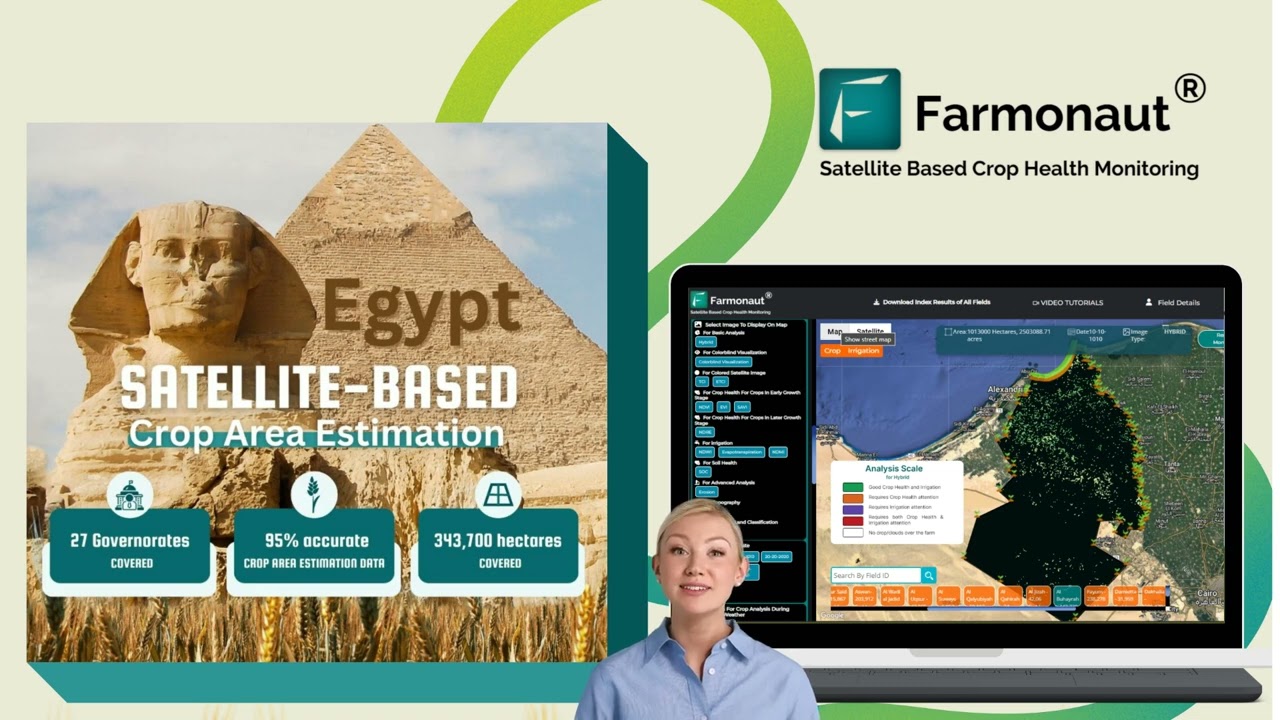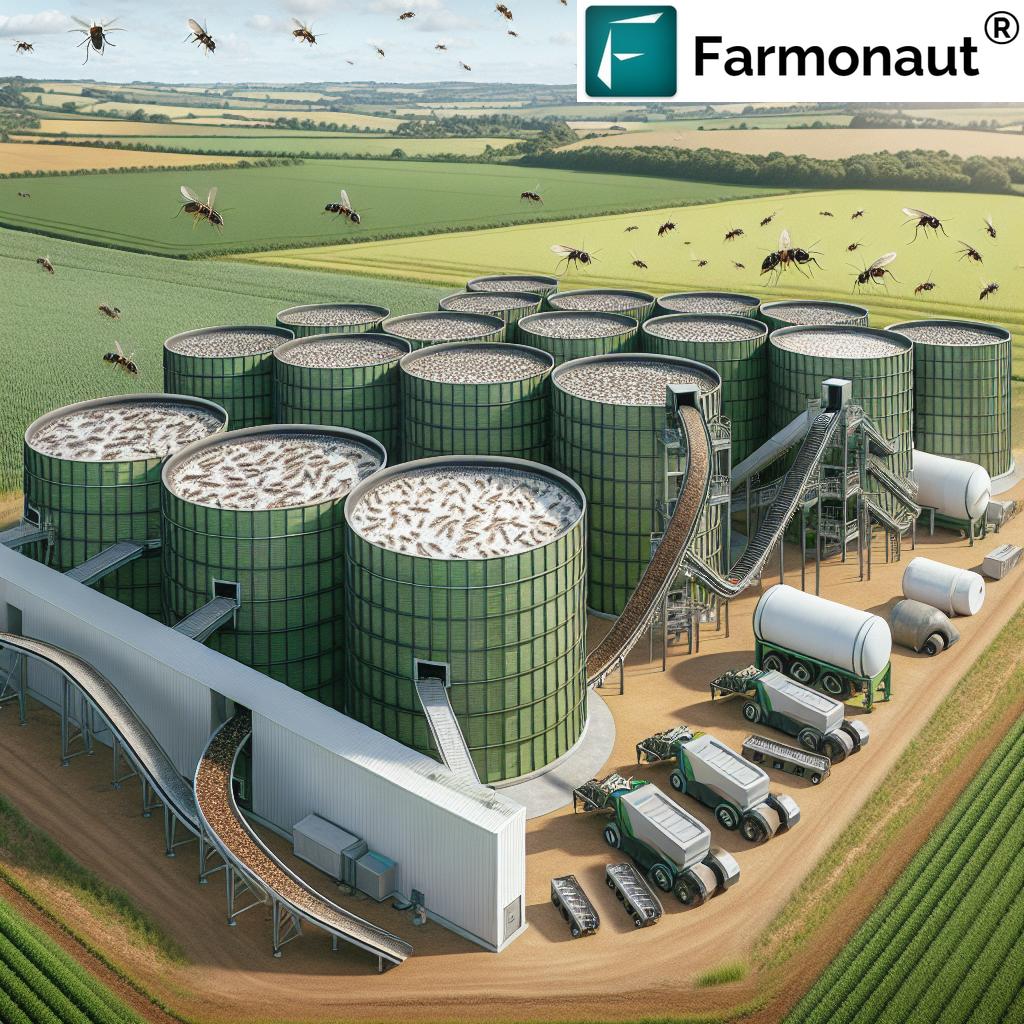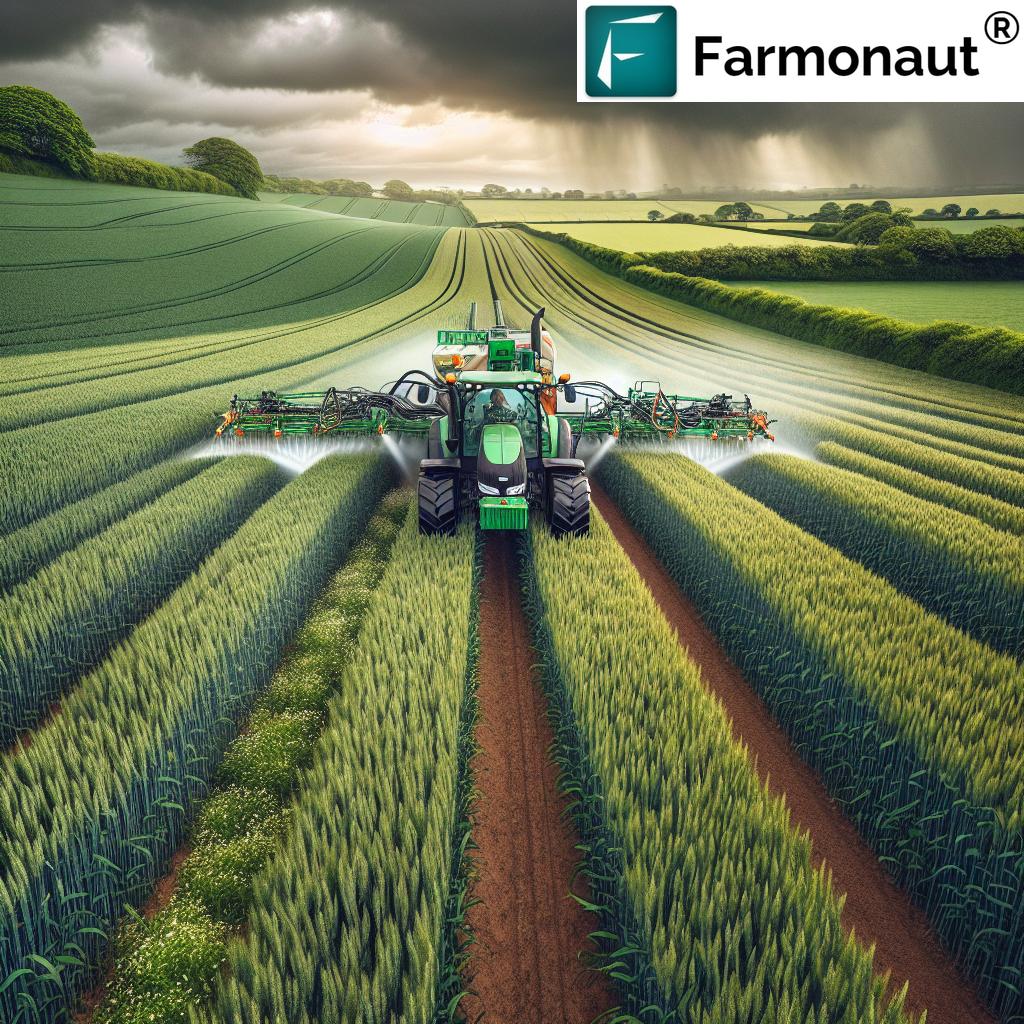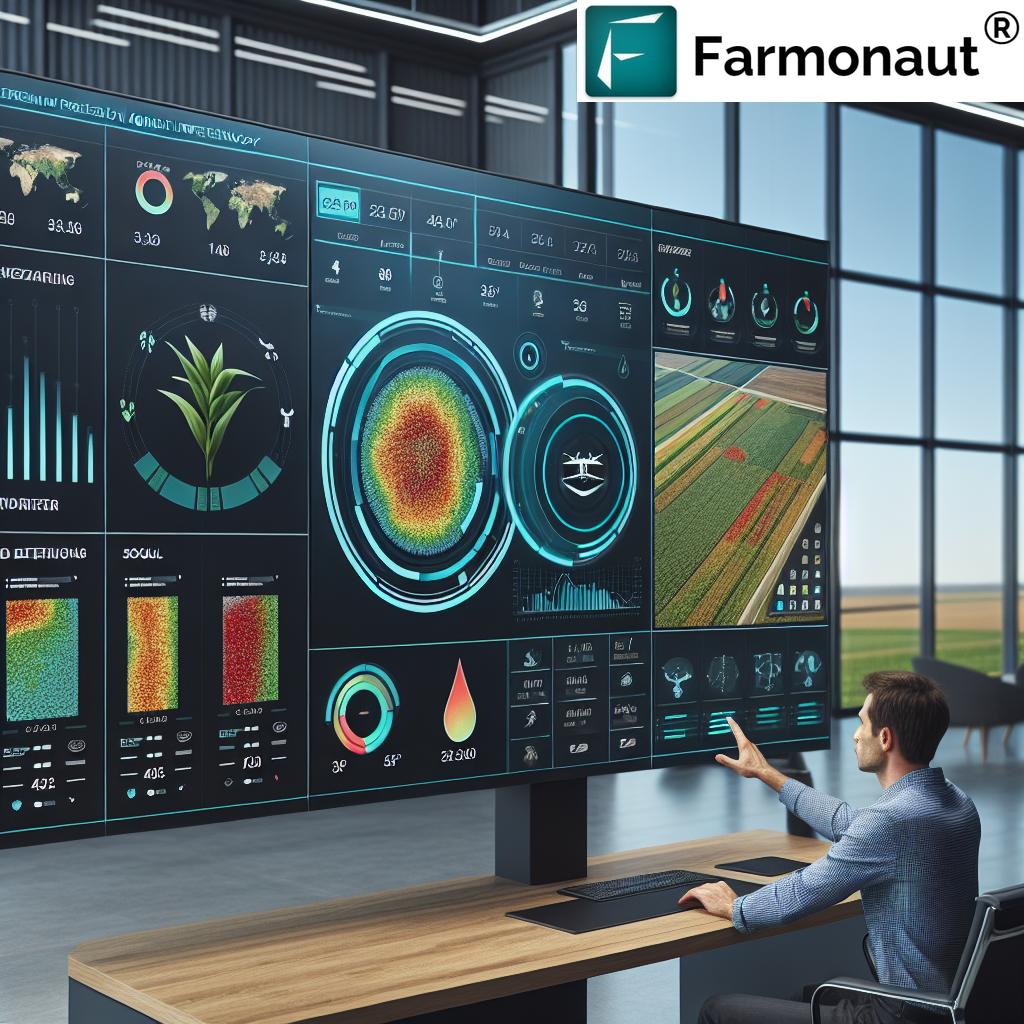Unlocking Irish Whiskey’s Secrets: How Technology and Tradition Shape Ireland’s Booming Spirit Industry
“Irish whiskey exports have grown by over 300% in the past decade, reaching a value of €1 billion annually.”
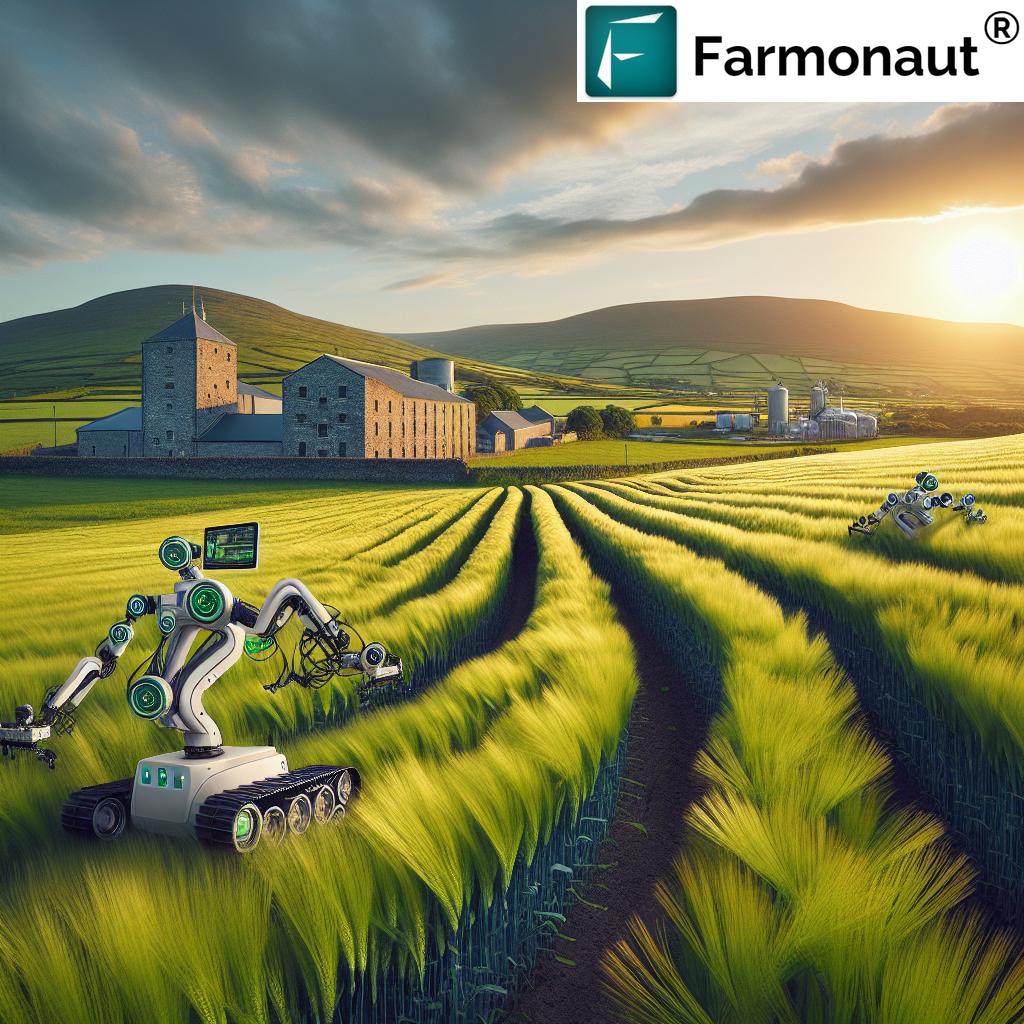
Welcome to a fascinating journey through the world of Irish whiskey production and agricultural technology in Ireland. As we delve into the resurgence of the Irish distillery industry, we’ll explore how cutting-edge innovations are harmoniously blending with centuries-old traditions to create some of the world’s finest spirits. From the rolling fields of barley to the time-honored stills, we’ll uncover the secrets behind Ireland’s booming whiskey sector and the pivotal role that agricultural advancements play in shaping this iconic product.
The Renaissance of Irish Whiskey
The Irish whiskey industry has experienced a remarkable renaissance in recent years. Once overshadowed by its Scottish counterpart, Irish whiskey has reclaimed its position as a global favorite, with a growing number of distilleries across the island nation. This resurgence is not just a testament to the spirit’s smooth, distinctive taste but also to the innovative approaches in both agriculture and distillation that have propelled the industry forward.
- Growth in distilleries: From just a handful in the 1980s to over 30 operational distilleries today
- Economic impact: Contributing significantly to Ireland’s rural economy and export value
- Innovation: Blending traditional methods with modern agricultural technology
As we explore the intricacies of Irish whiskey production, it’s essential to recognize the role of advanced agricultural solutions in enhancing crop quality and sustainability. Companies like Farmonaut are at the forefront of this agricultural revolution, offering satellite-based farm management solutions that can significantly impact the quality of raw materials used in whiskey production.
The Fundamentals of Irish Whiskey
Before we delve deeper into the technological advancements shaping the industry, let’s revisit the fundamentals that make Irish whiskey unique:
- Triple Distillation: Most Irish whiskeys are triple-distilled, resulting in a smoother finish
- Pot Still Whiskey: A style unique to Ireland, made from a mix of malted and unmalted barley
- Maturation: Legally required to age for at least three years in wooden casks
- No Peat: Generally, Irish whiskey is not peated, unlike many Scotch whiskies
These traditional aspects form the backbone of Irish whiskey’s identity. However, the industry’s recent growth has been fueled by a perfect blend of these time-honored practices and modern innovations in both distillation and agriculture.
EU Geographical Indicator Status: A Mark of Quality
One of the most significant developments in recent years has been the granting of EU geographical indicator status to Irish whiskey. This prestigious designation not only protects the integrity of Irish whiskey but also sets stringent quality standards that producers must meet.
- Ensures production occurs on the island of Ireland
- Mandates specific production methods and ingredients
- Enhances consumer trust and product authenticity
This status has played a crucial role in elevating Irish whiskey’s global reputation and has necessitated the implementation of rigorous whiskey quality assurance methods. From the selection of grains to the final bottling, every step of the production process is now subject to strict oversight.
The Science of Flavor: Whiskey Compounds and Aroma Identification
At the heart of every great Irish whiskey lies a complex interplay of whiskey flavor compounds. Understanding these compounds and their origins is crucial for both traditional distillers and modern innovators looking to create unique flavor profiles.
- Esters: Responsible for fruity notes
- Phenols: Contribute to smoky flavors (less prominent in Irish whiskey)
- Lactones: Impart woody, coconut-like aromas
- Aldehydes: Add nutty and grassy notes
Advanced aroma compound identification techniques, such as gas chromatography-mass spectrometry (GC-MS), have revolutionized how distillers analyze and refine their products. These methods allow for precise mapping of flavor profiles, ensuring consistency and enabling the creation of new, innovative whiskey styles.
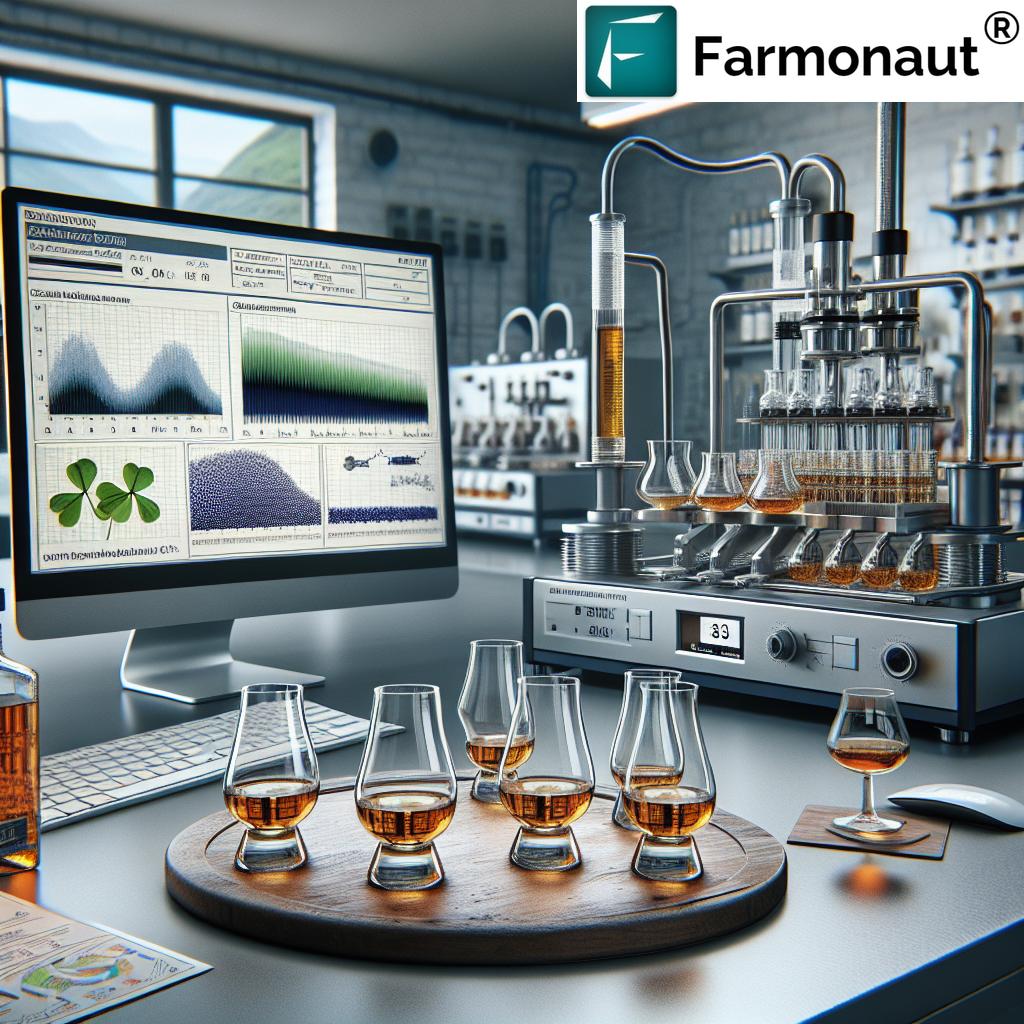
The Art and Science of Whiskey Sensory Analysis
Whiskey sensory analysis is a critical aspect of quality control and product development in the Irish whiskey industry. This process combines traditional tasting methods with modern scientific approaches to evaluate the complex sensory properties of whiskey.
- Visual Assessment: Color and clarity
- Olfactory Analysis: Identifying key aromas
- Gustatory Evaluation: Assessing flavors and mouthfeel
- Finish: Analyzing the lingering flavors and sensations
Modern sensory labs equipped with specialized software and standardized testing protocols ensure that each batch of whiskey meets the exacting standards set by master distillers. This blend of art and science is crucial in maintaining the consistency and quality that Irish whiskey is known for.
“The Irish whiskey industry employs over 1,600 people directly and supports 6,000 jobs in the agriculture sector.”
Agricultural Innovation: The Foundation of Quality Whiskey
The quality of Irish whiskey begins long before the distillation process, in the fertile fields where the grains are grown. Irish agricultural research has been pivotal in developing crop varieties that are ideally suited for whiskey production.
- Barley Breeding: Developing varieties with optimal starch content and enzyme levels
- Sustainable Farming Practices: Implementing techniques to reduce environmental impact
- Precision Agriculture: Utilizing technology for optimal crop management
Advanced agricultural technologies, such as those offered by Farmonaut, play a crucial role in modern farming practices. Their satellite-based crop monitoring systems can help farmers optimize growth conditions, ensuring the highest quality grains for whiskey production.
Crop Breeding for Whiskey Production: A Specialized Science
Crop breeding for whiskey production is a specialized field that combines traditional agricultural knowledge with cutting-edge genetics. The goal is to develop grain varieties that not only yield well but also possess the specific characteristics needed for high-quality whiskey production.
- Malting Quality: Breeding for optimal enzyme production during malting
- Flavor Precursors: Enhancing compounds that contribute to desirable whiskey flavors
- Disease Resistance: Developing varieties that require fewer pesticides, aligning with sustainability goals
This focused breeding approach ensures that Irish distillers have access to the best possible raw materials, contributing to the distinctive character of Irish whiskey. The collaboration between agricultural scientists and distillers is a prime example of how tradition and innovation intersect in the modern whiskey industry.
From Field to Glass: The Irish Whiskey Production Process
The journey from grain to glass is a complex one, involving multiple stages, each crucial to the final product’s quality and character. Let’s explore the key steps in Irish whiskey production and how modern technology is enhancing each phase:
| Production Stage | Traditional Method | Modern Technique | Impact on Flavor | Technology Used |
|---|---|---|---|---|
| Malting | Floor malting | Temperature-controlled malting chambers | Consistent malt flavor profile | IoT sensors, automated climate control |
| Mashing | Manual temperature control | Computerized mashing systems | Optimal sugar extraction, cleaner flavors | PLC systems, temperature probes |
| Fermentation | Open wooden washbacks | Stainless steel fermenters with temperature control | Consistent fermentation, enhanced yeast flavors | Automated cooling systems, yeast management software |
| Distillation | Copper pot stills, manual cut points | Computer-aided distillation, reflux analyzers | Precise flavor compound selection | Automated cut point systems, real-time analytics |
| Maturation | Static barrel aging | Monitored warehouses, barrel rotation | Controlled maturation, consistent wood influence | RFID tracking, climate-controlled warehouses |
1. Malting
The malting process is where the magic begins. Barley is steeped in water, allowed to germinate, and then dried to create malt. Modern malting facilities use advanced climate control systems to ensure consistent germination conditions, resulting in malt with optimal enzyme levels for whiskey production.
2. Mashing
During mashing, the malt is ground and mixed with hot water to extract fermentable sugars. Today’s mash tuns are equipped with precise temperature controls and automated stirring mechanisms, ensuring maximum efficiency and consistency in sugar extraction.
3. Fermentation
Yeast is added to the sugary liquid (wort) to begin fermentation. Modern fermentation vessels are often made of stainless steel and equipped with temperature control systems, allowing for precise management of the fermentation process and the development of desired flavor compounds.
4. Distillation
Irish whiskey is typically triple-distilled in copper pot stills. While the basic principle remains unchanged, modern distilleries employ advanced monitoring systems to ensure precise control over temperatures and cut points, allowing for consistent production of high-quality spirit.
5. Maturation
The final stage involves aging the spirit in wooden casks. Modern maturation warehouses use climate control systems and barrel management software to monitor and optimize the aging process, ensuring each cask reaches its full potential.
Throughout these stages, technologies like those provided by Farmonaut can play a crucial role in monitoring and optimizing the agricultural aspects of whiskey production. Their satellite-based crop monitoring and AI-driven advisory systems can help ensure the highest quality grains are used in the whiskey-making process.
The Role of Technology in Maintaining Product Authenticity
In an industry where tradition is highly valued, maintaining product authenticity while embracing technological advancements is crucial. Modern Irish whiskey producers are leveraging technology not only to enhance production but also to ensure the authenticity and traceability of their products.
- Blockchain Technology: Implementing blockchain for supply chain transparency
- NFC Tags: Using near-field communication tags for product verification
- Spectroscopic Analysis: Employing advanced analytical techniques to verify whiskey authenticity
These technologies play a vital role in combating counterfeiting and maintaining consumer trust in the Irish whiskey brand. They also align with the industry’s commitment to transparency and quality assurance.
The Future of Irish Whiskey: Innovations on the Horizon
As we look to the future, the Irish whiskey industry continues to evolve, blending respect for tradition with a forward-thinking approach to innovation. Some exciting developments on the horizon include:
- Precision Fermentation: Using genetically modified yeasts to create new flavor profiles
- Sustainable Distilling: Implementing zero-waste and carbon-neutral distilling processes
- AI-Driven Blending: Utilizing artificial intelligence to create optimal whiskey blends
- Virtual Reality Experiences: Offering immersive distillery tours and tasting experiences
These innovations promise to further enhance the quality, sustainability, and consumer experience of Irish whiskey, ensuring its continued growth and relevance in the global spirits market.
The Economic Impact of Irish Whiskey’s Resurgence
The revival of the Irish whiskey industry has had a significant impact on Ireland’s economy, particularly in rural areas. The industry’s growth has led to:
- Job creation in distilleries, agriculture, and related sectors
- Increased export revenues
- Tourism boost through whiskey trails and distillery visits
- Investment in research and development
This economic resurgence underscores the importance of the whiskey industry to Ireland’s national economy and highlights the successful blend of traditional craftsmanship with modern innovation.
Conclusion: A Spirit of Innovation
The story of Irish whiskey is one of resilience, tradition, and innovation. From the fields where the grains are grown to the sophisticated distilleries where the spirit is crafted, technology plays a crucial role in every step of the process. Yet, it’s the harmonious blend of these modern techniques with time-honored traditions that truly defines the character of Irish whiskey.
As we’ve explored, companies like Farmonaut are at the forefront of agricultural innovation, providing tools that can significantly impact the quality of raw materials used in whiskey production. Their satellite-based crop monitoring and AI-driven advisory systems represent the kind of cutting-edge technology that is shaping the future of agriculture and, by extension, the whiskey industry.
The Irish whiskey industry stands as a testament to how traditional craftsmanship can be enhanced, rather than replaced, by modern technology. As the industry continues to grow and evolve, it remains committed to producing spirits of the highest quality, leveraging the best of both worlds to create whiskeys that are distinctly Irish and universally appreciated.
FAQ Section
Q1: What makes Irish whiskey unique compared to other whiskeys?
A1: Irish whiskey is typically triple-distilled, resulting in a smoother taste. It also often uses a mix of malted and unmalted barley and is generally not peated, giving it a distinct flavor profile.
Q2: How has technology impacted Irish whiskey production?
A2: Technology has enhanced every stage of production, from precision agriculture in grain cultivation to automated distillation processes and AI-assisted quality control, while maintaining traditional craftsmanship.
Q3: What is the significance of EU geographical indicator status for Irish whiskey?
A3: This status protects the authenticity of Irish whiskey, ensuring it’s produced in Ireland according to specific standards, thus maintaining its quality and reputation.
Q4: How does crop breeding contribute to whiskey quality?
A4: Specialized crop breeding develops grain varieties with optimal characteristics for whiskey production, such as higher starch content and specific flavor precursors.
Q5: What role does sensory analysis play in whiskey production?
A5: Sensory analysis combines traditional tasting methods with scientific approaches to evaluate and maintain the consistency and quality of whiskey across different batches.
Explore Advanced Agricultural Solutions with Farmonaut
As we’ve seen, the quality of Irish whiskey begins in the fields where the grains are grown. Farmonaut’s advanced agricultural solutions can play a crucial role in optimizing crop growth and quality, directly impacting the whiskey production process. Explore how Farmonaut can revolutionize your agricultural practices:

Download Farmonaut’s Android App


For developers interested in integrating Farmonaut’s powerful agricultural data into their own applications:
Farmonaut Subscription Options
By leveraging Farmonaut’s cutting-edge agricultural technology, whiskey producers can ensure the highest quality grains for their spirits, contributing to the ongoing excellence and innovation in the Irish whiskey industry.


